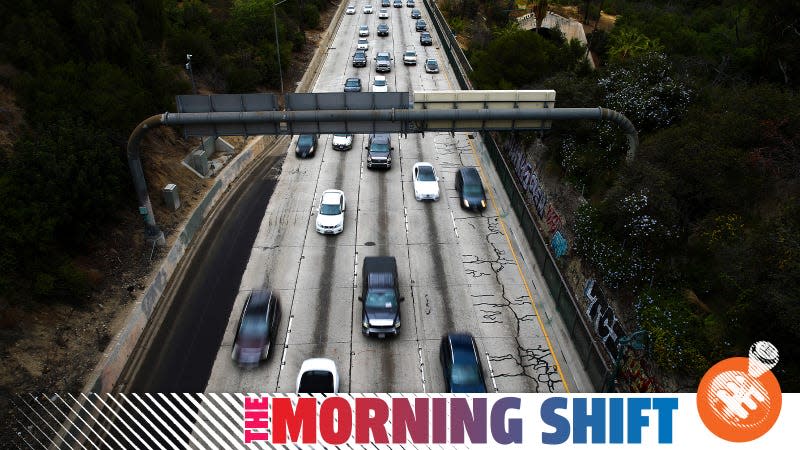EPA Wants Automakers to Slash Emissions by More Than Half Over Five Years

The Biden administration has put forth tough emissions criteria for the end of the decade, Volkswagen’s brand chief has been candid about the task of building an electric vehicle that everyone can afford, and a Ford factory in Ontario will be reborn next year. All that and more in this edition of The Morning Shift for Wednesday, April 12, 2023.
1st Gear: Target 2032
The Environmental Protection Agency has announced its proposal for the next wave of new-vehicle emissions standards that will take effect from model years 2027 to 2032. The EPA won’t complete the proposal until spring of next year, but the broad strokes are visible now — and they involve reducing fleet-wide pollution by 56 percent by the end of that span, as compared to 2026 targets. From Reuters:
Read more
The EPA projects the 2027-2032 model year rules would cut more than 9 billion tons of CO2 emissions through 2055 - equivalent to more than twice total U.S. CO2 emissions last year.
Automakers and environmentalists say the administration is moving quickly in order to finalize new rules by early 2024 to make it much harder for a future Congress or president to reverse them. Then-President Donald Trump rolled back tough emissions limits through 2025 set under Barack Obama but the Biden administration reversed the rollback.
The agency estimates net benefits through 2055 from the proposal range from $850 billion to $1.6 trillion. By 2032 the proposal would cost about $1,200 per vehicle per manufacturer, but save an owner more than $9,000 on average on fuel, maintenance, and repair costs over an eight-year period.
The Biden administration naturally expects automakers to comply with these regulations largely through electrification. As NPR clarifies, the government isn’t mandating a minimum number of EVs to be sold, but it does foresee that shift happening to make the 56-percent reduction possible. From NPR:
The EPA is not proposing to directly require that 67% of vehicles be zero-emission by 2032.
Instead, it sets a standard for emissions, on average, based on the size and type of vehicle being built. The agency says those new rules are so stringent that it believes companies will need to produce 67% zero-emission vehicles to meet them.
That said, if the Department of Energy manages to rewrite how it evaluates EV efficiency, as we discussed in Tuesday’s Morning Shift, it would mean that internal combustion-powered cars would have to be a lot more efficient as well. Also, manufacturers couldn’t hit the targets simply by electrifying big vehicles; they’d have to get creative and maybe — gasp — downsize.
Obviously lots of this hinges upon the outcome of the next presidential election. But then, rational automakers know that even if Trump won again and legally reversed all of this, every other market would still demand a reduction in carbon emissions and, eventually, the U.S. would, too. You may as well just prepare for that inevitability. Unless you’re General Motors and see fit to scrap your plans every four years.
2nd Gear: Speaking of Smaller EVs
Automotive News Europe just published an extensive interview with Volkswagen’s Thomas Schäfer, in which the brand CEO gave surprisingly short, direct answers about the challenges of selling a cheap volume EV in the near future. For example, here’s what Schäfer said when asked if Volkswagen will be able to achieve the margins it needs with the ID2all:
We cannot have margins below 6 percent. With the scale we have with four vehicles from three brands [on the same MEB Entry platform] — two from VW, one from Cupra and one from Skoda — I guarantee we can. We are not a charity. We intend to make money.
And here’s what he said about how the company will get there:
Either you solve the riddle with scale, downsize the battery, or you find a partner and scale it even more. It’s not clear yet. We have four working streams in parallel at the moment.
And here’s what he said about the feasibility of internal-combustion cars like the Polo continuing late into the decade:
The question is: What will the Polo cost after Euro 7 [emissions regulations] take effect? We don’t know yet. If you look at what the European Union posted about Euro 7 last November, then smaller combustion engine vehicles will become prohibitively expensive. At the moment, you can buy a Polo with a manual gearbox and 1.0-liter engine, but under Euro 7, this would be not be possible anymore. You need an automatic gearbox and you need hybridization. The future of Polo depends on the outcome of Euro 7. [...] We would rather put our money into electrification during the final years of the combustion engine than make a final version of [the Polo] that is prohibitively expensive.
When asked about Germany’s stalling of the European Commission’s combustion engine ban over e-fuels — a measure his boss, VW Group CEO Oliver Blume, supports — Schäfer didn’t mince words, either:
That’s unnecessary noise from my point of view. By 2035 [combustion engines] are over anyway. We said by 2033 we’re done. By 2030 we plan that 80 percent of our vehicles sold in Europe are battery electric, so why spend a fortune on old technology that doesn’t really give you any benefit?
Those are the highlights, but this is an insightful chat in its entirety that’s well worth a read. Schäfer also spoke of a GTI variant of the ID2all, to cash in on the opportunity for wider margins from a higher-spec trim. “We can move up the price ladder with various models,” the brand chief said. “What we are definitely not going to do is repeat what we did in the past and sell a confusing amount of variants.” The guy knows how to make a point.

 Yahoo Autos
Yahoo Autos 